Commitment to the Community
1940s
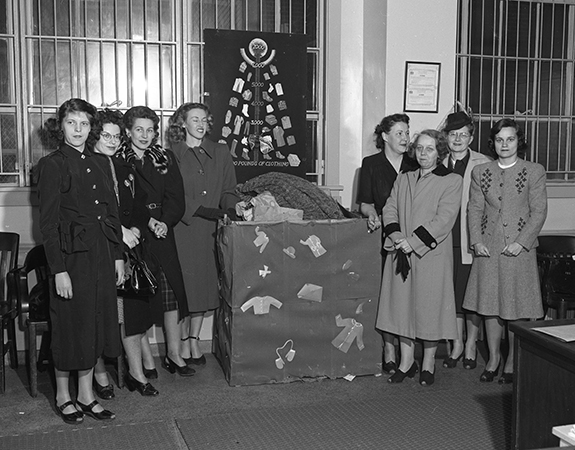
Coats for Post-War Europe 1947
Staff members collect clothing and other items for war-torn countries in Europe. APL employees contribute a total of 2,025 pounds of clothing in the two-week drive; the clothes are then sent by the Washington Area Relief Mobilization to needy families in former occupied countries.
1950s
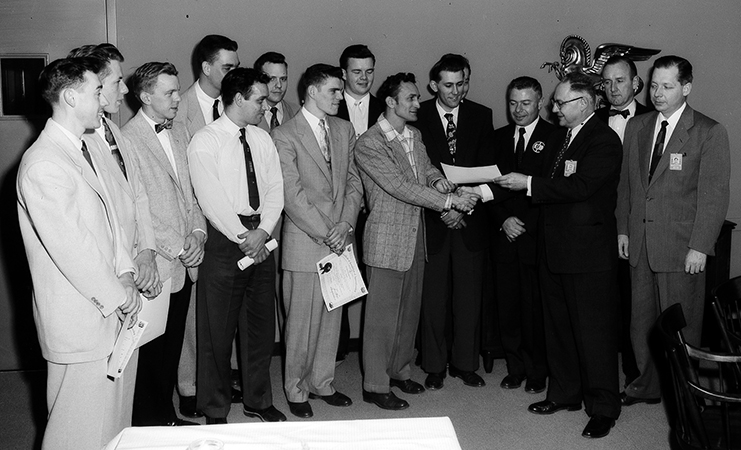
Apprentice Training Program Introduced at APL January 1951
An apprenticeship program is created to provide “trades for Montgomery County youth and a reserve of skilled artisans to fit into scientific research.” The Lab initially seeks high school graduates with mechanical aptitudes leading to the rating of full-fledged journeyman machinist and a position on the Applied Physics Laboratory staff. The program is carried out through cooperation of the Bureau of Apprenticeship, U.S. Department of Labor.
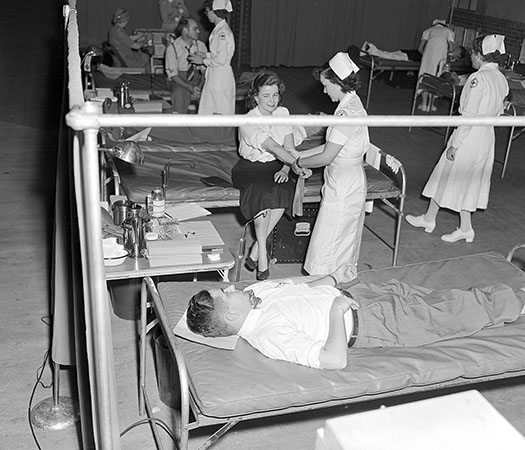
APL Gives the Gift of Life 1951
APL staff members give blood at the Silver Spring Armory, and many are members of the eight-time donors group known as the Gallon Club. In 1964, the bloodmobile begins making regular visits to the Howard County campus.
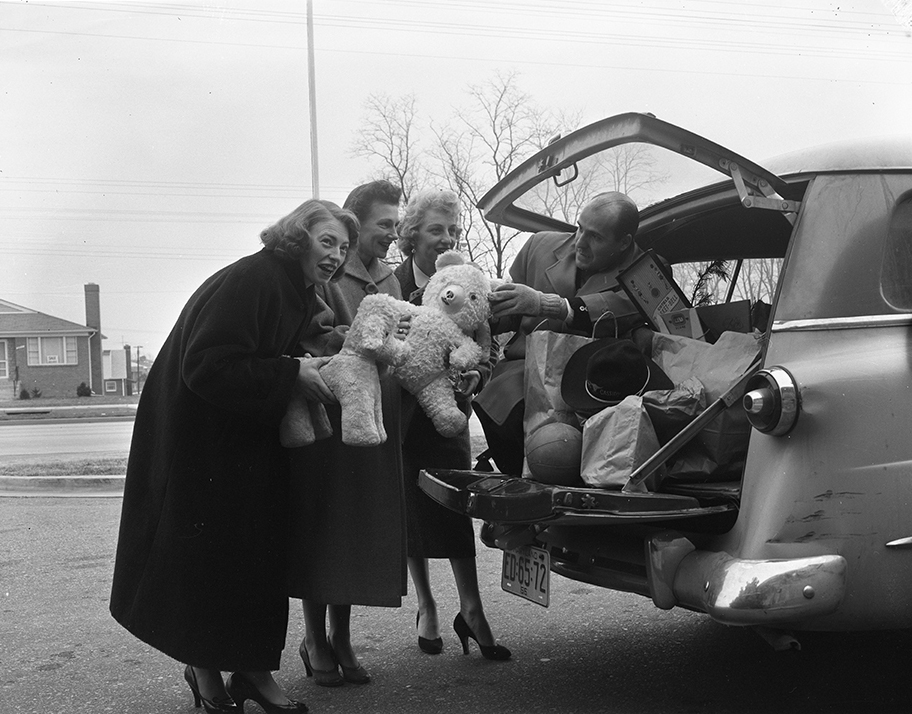
The Lab Participates in Toys for Tots December 1955
Carolyn Oberlin, Ruth Moore, Vera Wolchick, and Bill Groff load a station wagon with donated toys for a trip to the Howard County Community Chest Center.
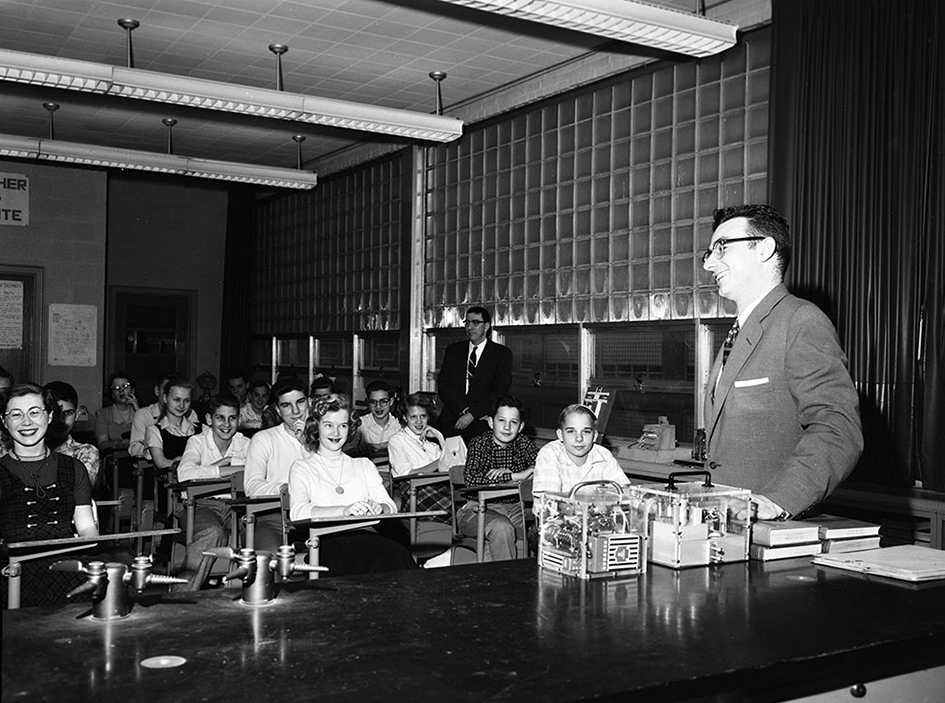
APL Scientists Pitch in as Substitute Teachers 1956
William H. Guier, one of the creators of satellite-based navigation, takes over the lesson at Eastern Junior High School in Silver Spring. Principal Hillary C. Rockwell observes in the background.
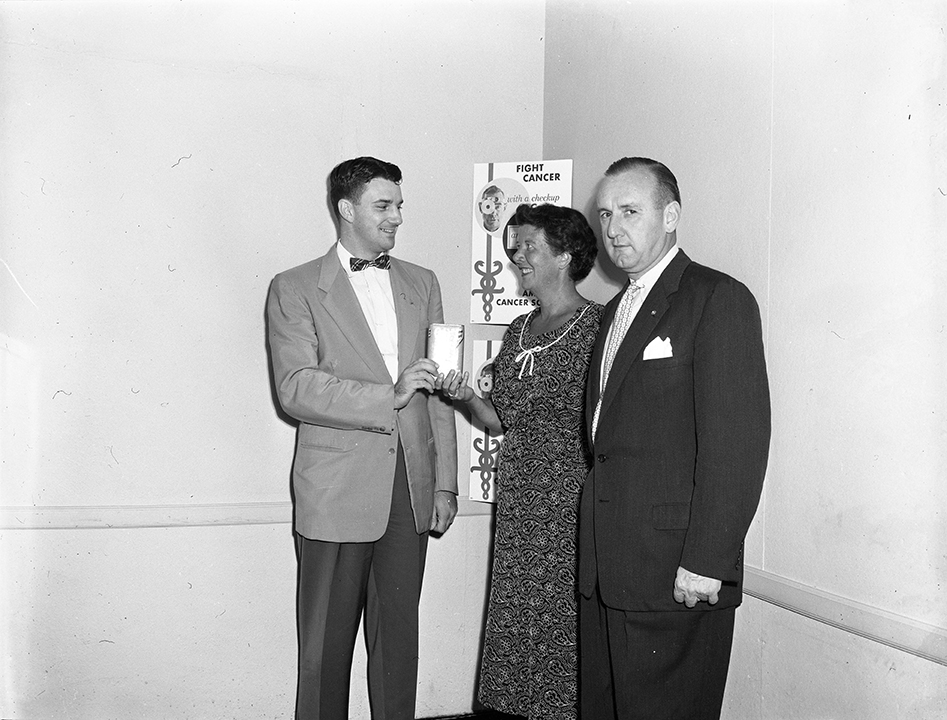
Fundraiser for American Cancer Society 1956
From The APL News: “Mrs. Helen D. Sherbert, right, hands over her private mite box to Lawrence B. Maloney, Jr., local business and trades chairman of the American Cancer Society drive. Helen filled her mighty mite box through donations in lieu of fees for her services as a notary. The box was also fattened by donations of APLers. Helen’s year-long cancer drive caught attention of local columnist, Betty McDevitt, Maryland News, and other members of the community. [Maloney] came to APL to pay respects to Mrs. Sherbert, cite her, and receive the contribution of her unopened mite box. It contained $37.59 [about $260 in 2017 dollars].”
1960s
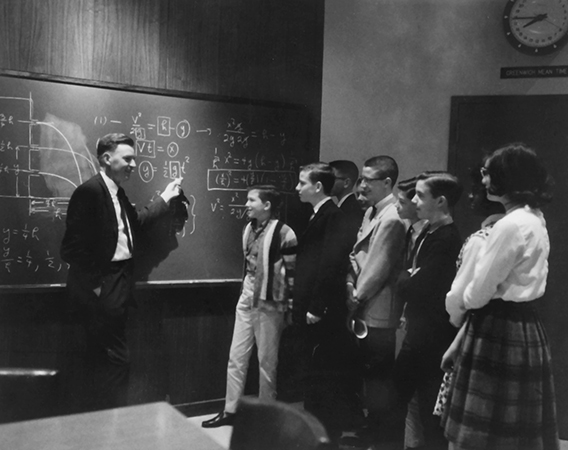
Staff Members Make Educational Outreach 1965
APL’s Hugh Donelly explains engineering concepts to 8th and 9th grade students from Howard County schools, part of the Lab’s long history of educational outreach to Maryland schools and children.
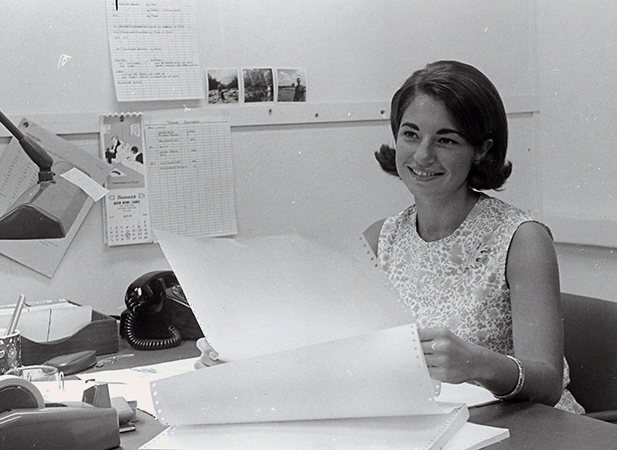
Student Summer Staff 1966
Suzanne Lee, St. Mary’s College, South Bend, Indiana, examines results of Polaris tests in PAE. APL continues its tradition of mentoring students. More than 45 summer students contribute to the Lab that year. Their work and even their designs are implemented in big projects for the Navy and NASA spacecraft.
1970s
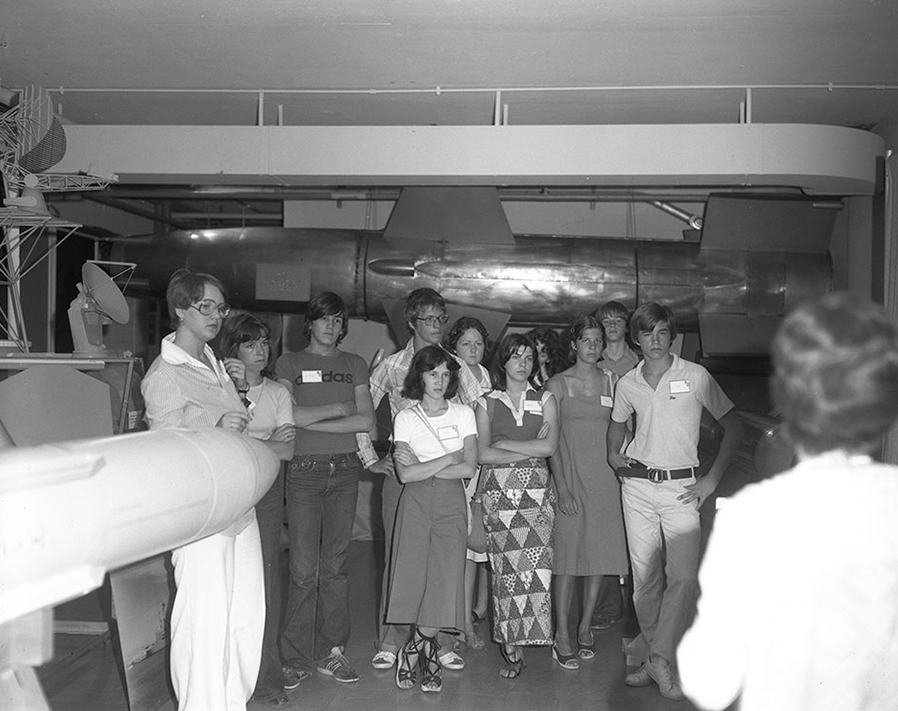
High School Students Visit the Lab 1970
Students from local high schools learn about the inner workings of APL.
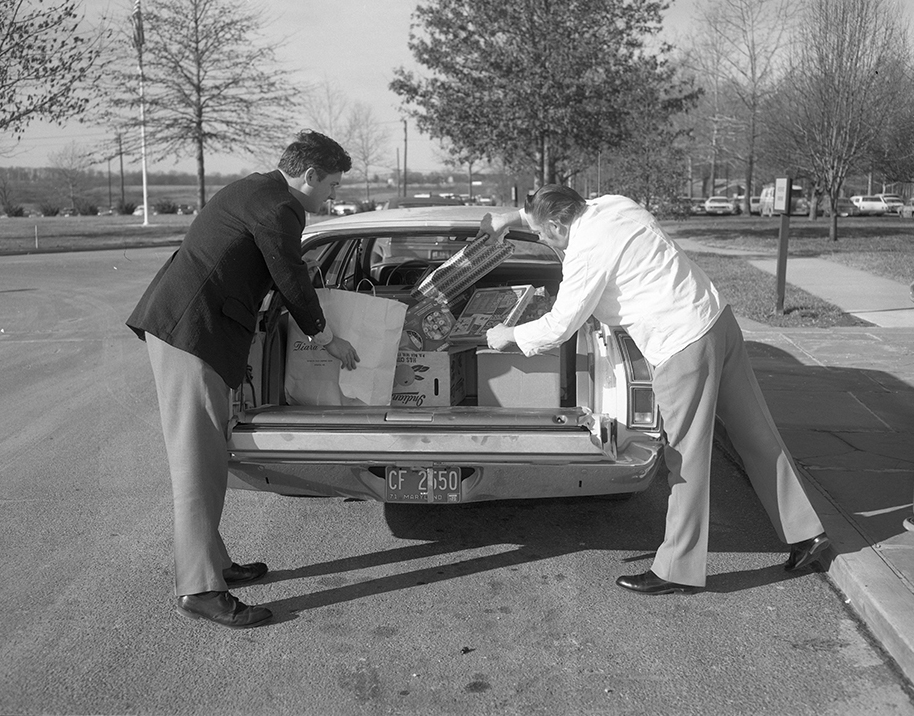
Gifts for Sick Children 1975
APLRinc thanks staff members who contribute almost $150.00 and 68 gifts that are then donated to Children’s Hospital at Christmas. APLRinc Board member William Kehoe and Assistant Cafeteria Manager Gordon Bull load the station wagon with gifts for transfer to the hospital. In 1974, the United Giving Fund and the Health and Welfare Council (HWC) merged their operations, staffs, and resources to form the new United Way. APL has consistently participated in the United Way since the Lab first opened.
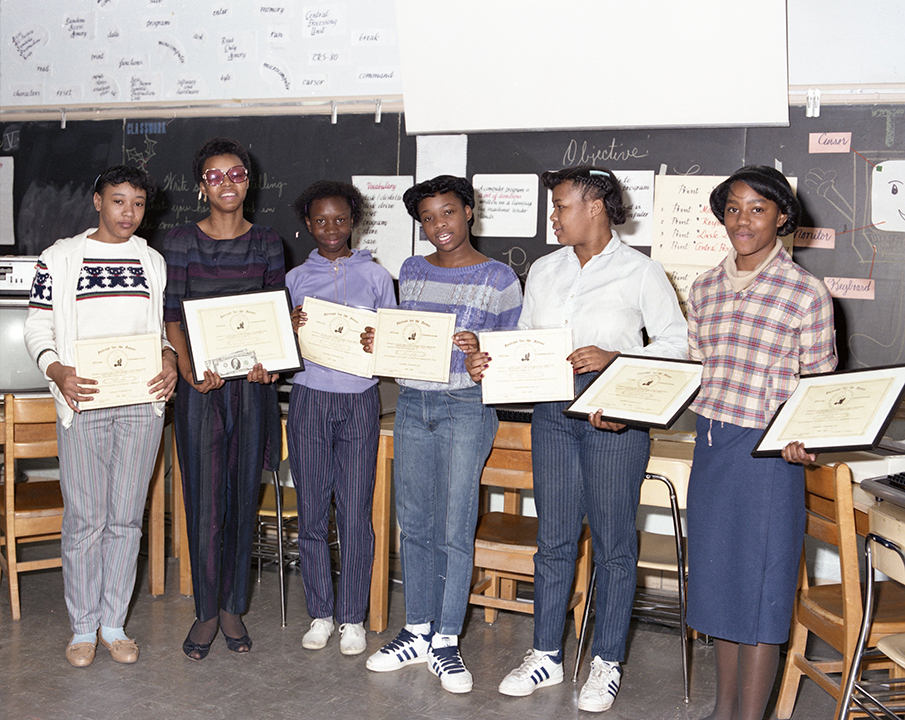
Maryland MESA Founded January 1976
The Maryland Mathematics, Engineering, Science Achievement (MESA) program is established at APL with two schools in Baltimore City. Maryland MESA is a structured K-12 program designed to prepare students for academic and professional careers in mathematics, engineering, science, and technology.
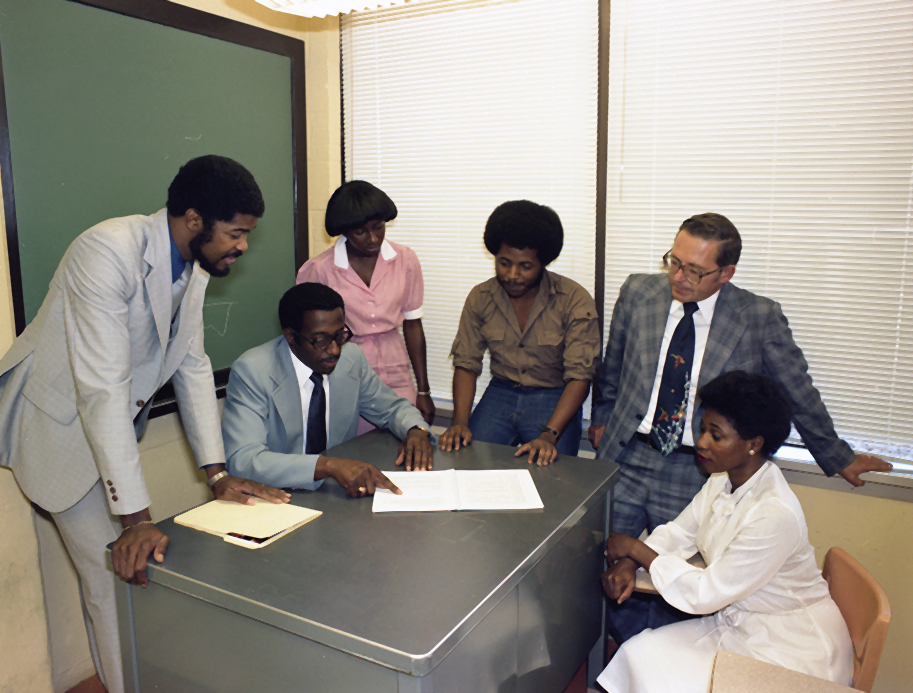
A GEM of a Program 1976
APL’s affirmative action officer, Ted Habarth, has a vision in 1974. Concerned about the underrepresentation of minority students in graduate science and engineering programs, Habarth, collaborating with Rev. Theodore Hesburgh, then president of the University of Notre Dame, and several other organizations, founds “GEM” – The National Consortium for Graduate Degrees for Minorities in Engineering and Science, Inc. Six masters in engineering fellowships are awarded in 1976.
1980s
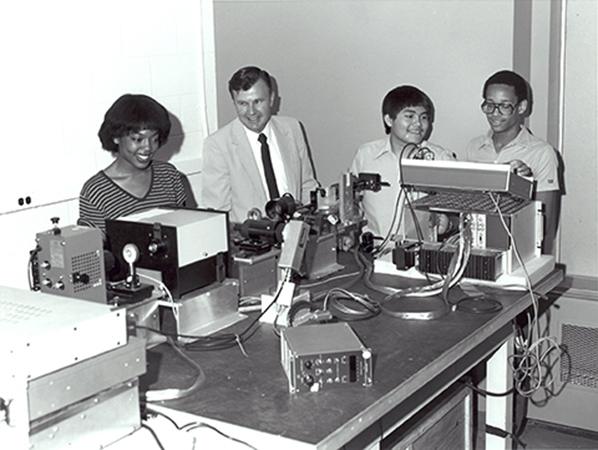
High School Summer Apprenticeship 1982
A nine-week summer apprenticeship program, sponsored and funded nationally by the Army Research Office through the Academy of Applied Sciences, is launched for high school students. Students are selected based on teachers’ recommendations, grades, SAT scores, and extended interviews by a Research Center panel.
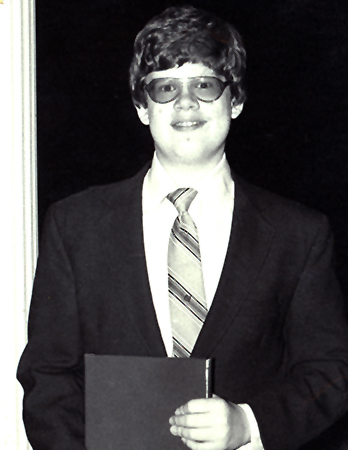
First Kershner Scholarship Awarded June 1983
Michael Sofas, age 14, from Pocono High School in Swiftwater, Pennsylvania, is the inaugural recipient of APL’s Kershner scholarship, which was set up in memory of the late Richard Kershner, former assistant director and longtime head of APL’s space programs. The fund continues to provide scholarships for highly qualified students attending the summer JHU Center for the Advancement of Academically Talented Youth.
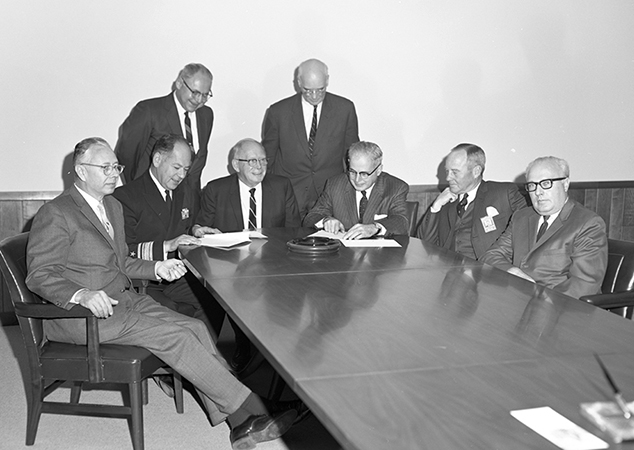
The First Janney Program 1984
Stuart Janney Jr. (second from right) in a 1969 photo, seated with APL and Johns Hopkins University leaders. The Lab establishes a new fellowship program to give staff members the opportunity to conduct short-term research projects that would otherwise be impossible to pursue given regular deadlines and budgetary constraints. Named for Stuart Janney Jr., who chaired the Trustees’ Committee on APL from 1957 to 1971, the fellowships are awarded by the APL director and fund multiple research projects each year.
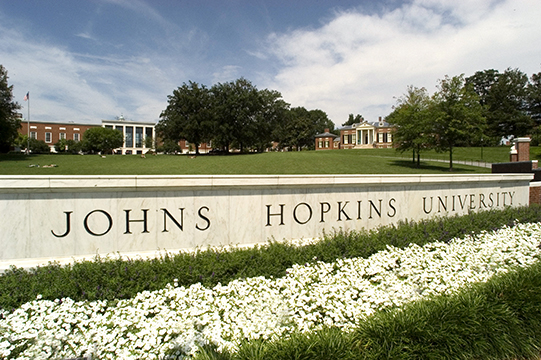
APL’s Campaign for Johns Hopkins September 11, 1984
The Lab participates in a fundraising effort for the Johns Hopkins University and its divisions as well as the Johns Hopkins Hospital, a five-year campaign intended to raise $450 million in support of teaching, research, and patient care.

APL Donates Van for Food Distribution July 24, 1985
Pete Newman, right, head of transportation and traffic at APL, presents keys to the van (background) to Dottie Moore, Executive Director of the Howard County Community Action Council. The vehicle will be used to distribute food to those in need in Howard County. June Hamm, left, APL office services supervisor, coordinates the transfer of the used van from the Laboratory to the community action group.
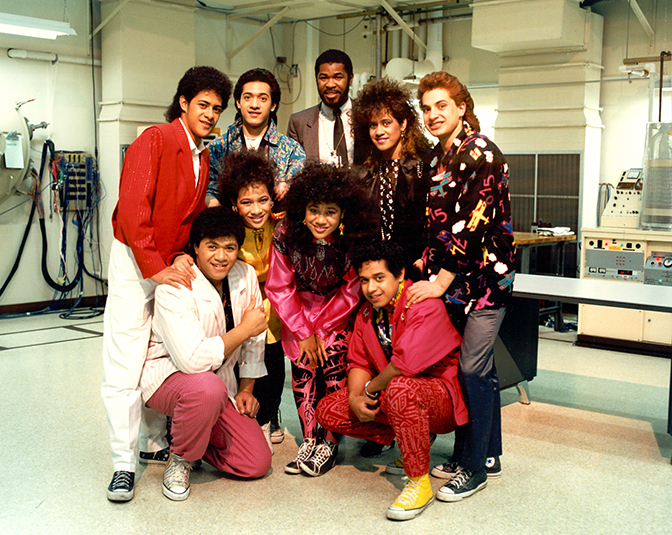
The Jets Land at APL April 30, 1986
The Jets, an eight-member family rock group, tape portions of their 13-part TV series in the Kershner Space Building. The series, “Journey: Exploration in Science and Engineering,” is produced by the National Consortium for Graduate Degrees for Minorities in Engineering and Science, Inc. (GEM), and focuses on encouraging junior and high school minority students to consider a science or engineering career. APL’s Robert Willis (rear center) escorts the group.

APL Joins Hopkins Women’s Network 1987
The Hopkins Women’s Network (HWN) is not just an APL group; it’s a university-wide organization with chapters at The Johns Hopkins Medical Institutes, Bayview Medical Center, the University’s Homewood campus, and APL. HWN is founded in 1987 and offers women from all Hopkins campuses opportunities for educational and cultural growth, professional networking, and a voice for issues of concern to Hopkins women. The group has provided input to University and APL administration on issues ranging from equity in salaries to childcare to sexual harassment prevention.
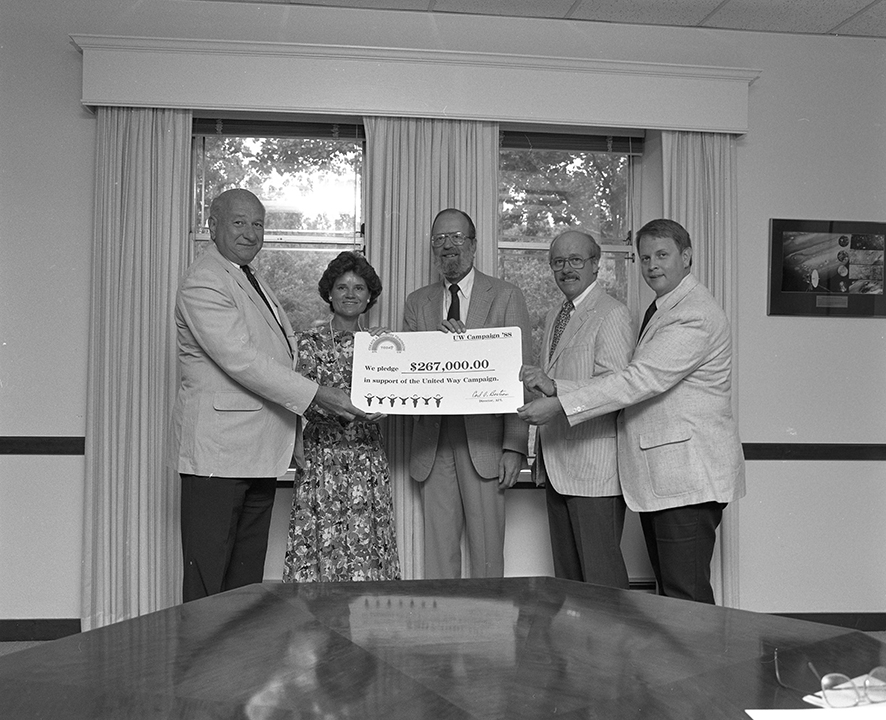
United Way Campaign of 1988 October 1988
The Lab has long supported the United Way. APL Director Carl Bostrom is shown here holding a certificate of an APL pledge for the United Way.
1990s
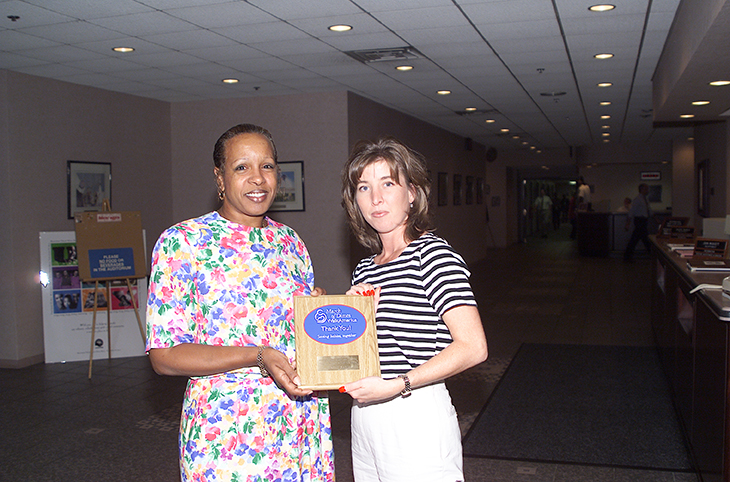
March of Dimes Recognizes APL Staffer’s Efforts April 1999
Maggie Sands (left), of the Air Defense Systems Department, is honored by the March of Dimes for raising $1,000, the most money of the 750 individual walkers, in Howard County’s March of Dimes WalkAmerica campaign in April 1999. She also captained a team of APL staff members for the event. She is shown receiving the award from Katie Stover, walk coordinator for Central Maryland.
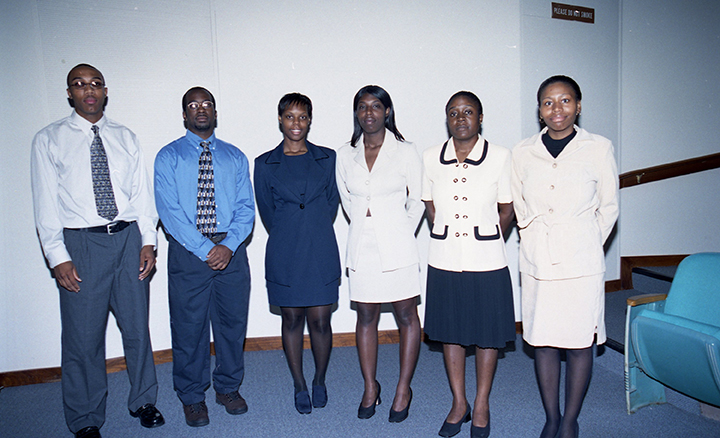
College Intern Program Wraps Up First Year September 1999
The APL Technology Leaders Summer Scholars (ATLAS) program completes its first year. The class—nine students drawn from Bowie State, Clark Atlanta, and Prairie View A&M universities—wraps up its summer by making final project presentations to members of their departments. They also visit the Patuxent Naval Air Station and tour the Pentagon, which features a visit with Hans Mark, director of Defense Research and Engineering.
2000s
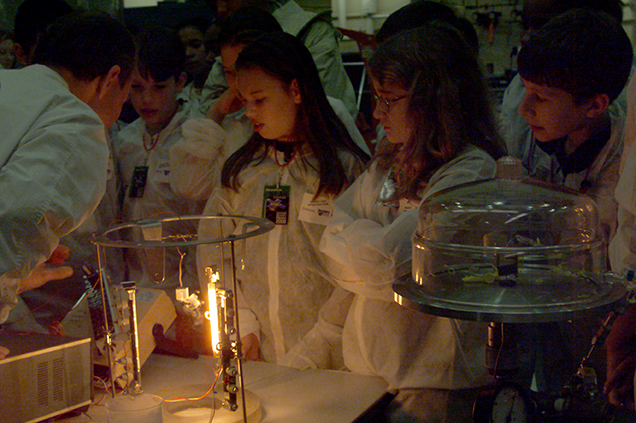
Inspiring Careers in Space April 14, 2000
As a prelude to National Space Day, the Lab teams up with Comcast, Discovery Networks, and the Maryland State Department of Education to give more than 100 students a true outer space experience—moving from behind their desks to behind the scenes of a real deep-space mission during Comcast-Discovery Mission 2000: Operation NEAR. In an event that evolves into the popular Space Academy series, the kids take part in a student press conference with Near Earth Asteroid Rendezvous (NEAR) team members, then don special cleanroom suits and tour the Lab’s space facilities.

‘Super Bowl’ of Science March 30, 2001
Maryland Governor Parris Glendening presents APL with a citation for managing the successful Near Earth Asteroid Rendezvous (NEAR) mission and boosting the state’s scientific reputation. The governor remarks how just a few months earlier, the Baltimore Ravens won the Super Bowl. “Sports successes are exciting and fun, but what’s most exciting is that issue after issue, Maryland leads the entire world in science, technology and discovery.” Project scientist Andy Cheng is among team members to visit the State House and answer questions from students and science teachers who attend the ceremony.
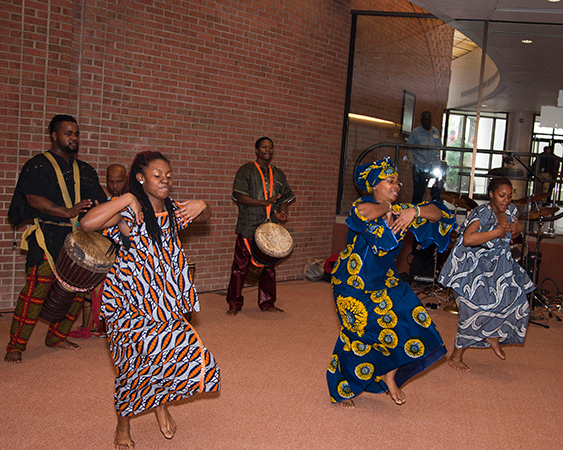
African American Culture Club Launches 2003
The African American Culture Club (AACC) forms to celebrate and build on the rich resource of APL’s diversity of people and cultures, particularly people of African descent. The group is an important part of an ongoing multicultural effort to foster a professional community that reflects unity, creativity, and shared responsibility. AACC merges with the Black Faculty and Staff Association in 2017.
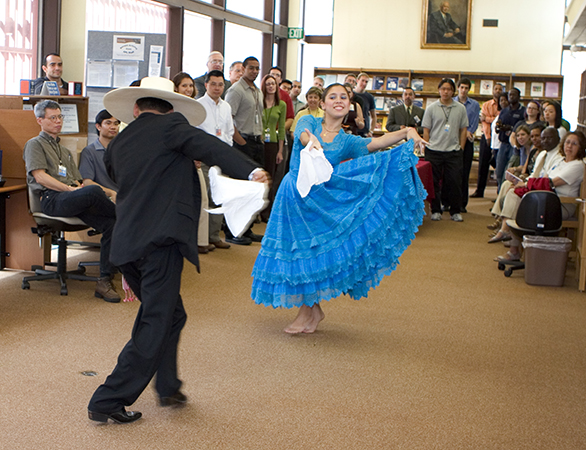
Hispanic Awareness Club Forms 2003
A newly formed APL Hispanic Awareness Club comes together as a grassroots effort by Hispanic staff members to bring awareness of their culture to the Lab and help in its effort to hire, promote, and retain Hispanic staff members.
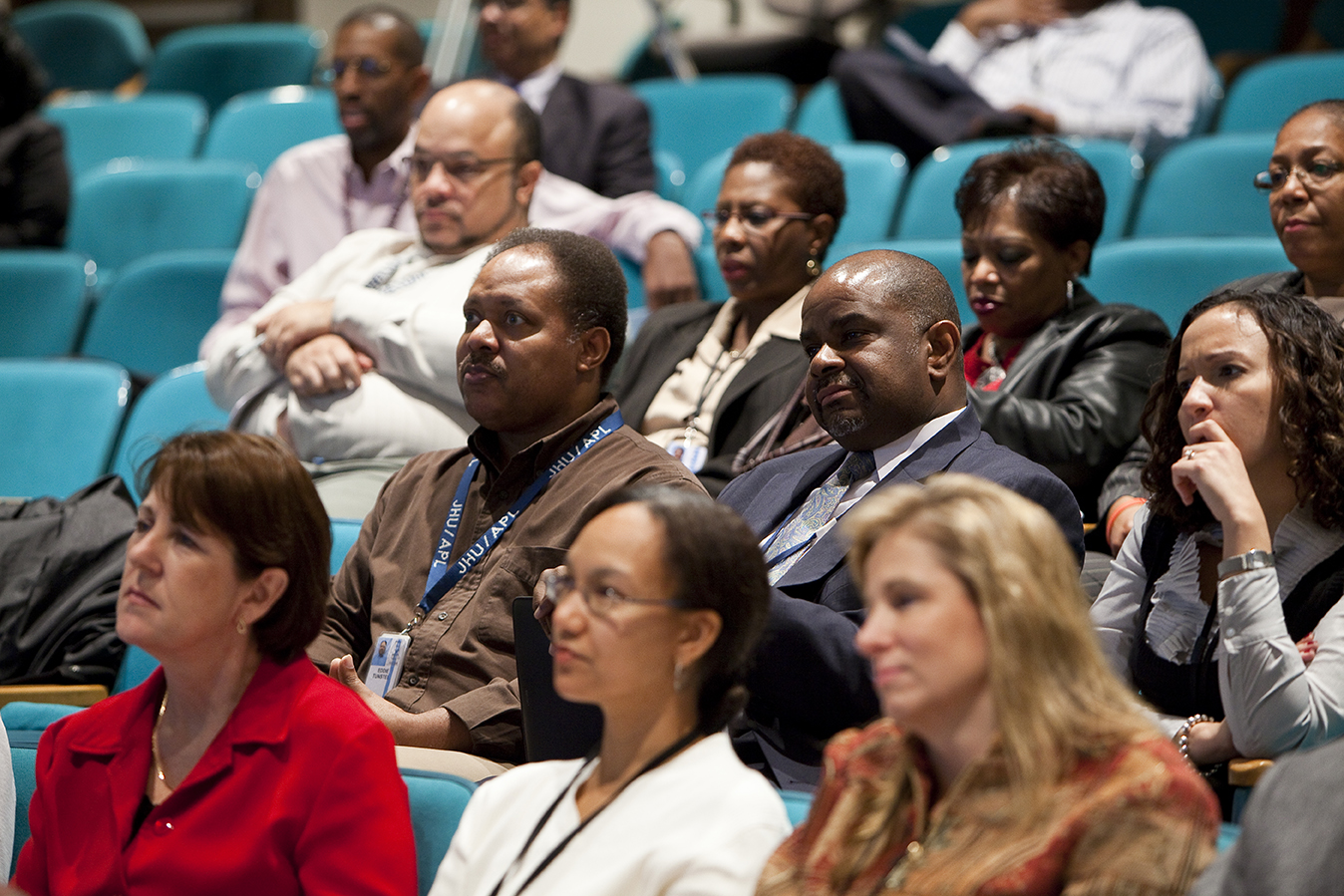
APL Caucus of Black Faculty and Staff Association Forms 2006
The Black Faculty and Staff Association (BFSA), a Johns Hopkins University-wide organization, promotes and enhances identity, a sense of community, and professional welfare and development among black faculty, staff, and students. The organization brings together and works with people of color within the broad community of Johns Hopkins institutions. APL forms a caucus of staff members within the BFSA.
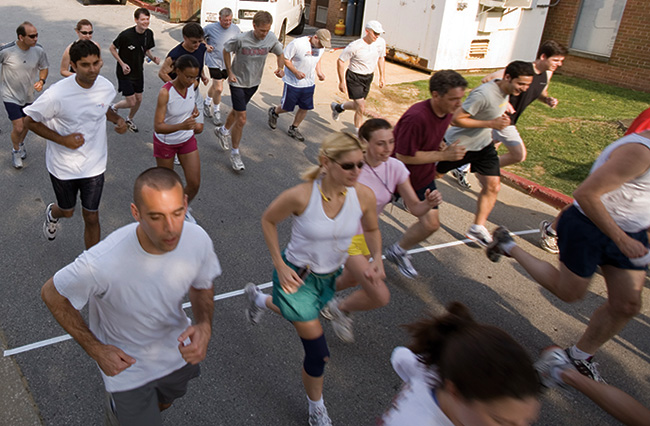
Health Improvement Committee Sponsors Its First 5K Fun Run/Walk June 8, 2006
Carlos Renjifo comes in first in the first 5K Fun Run/Walk sponsored by APL’s Health Improvement Committee, on June 8, 2006. The event is part of the “APL In the Zone” program, which aims to increase and promote physical fitness and well-being among staff members, and to help individuals reach their personal fitness goals.
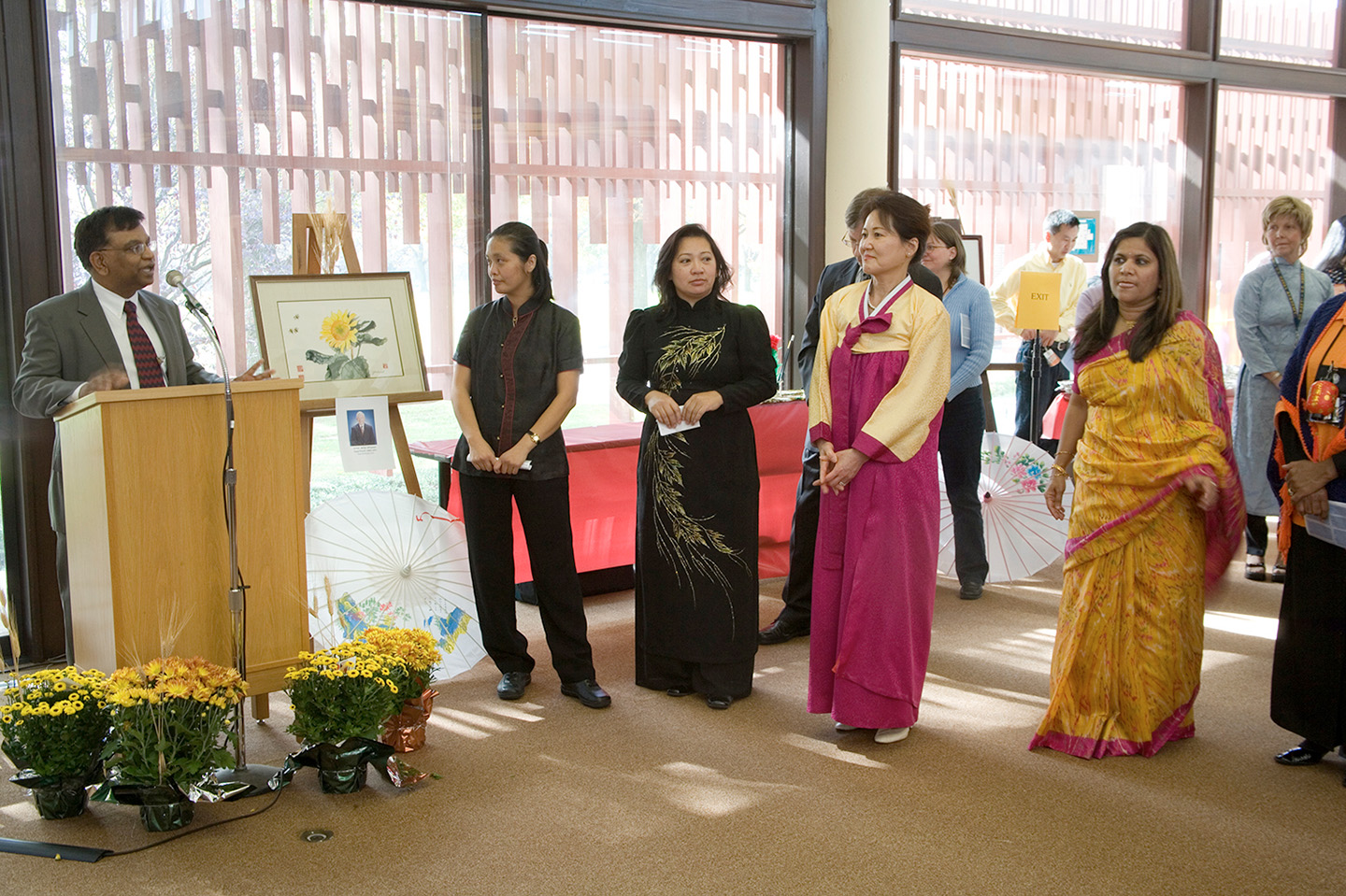
Asian American Heritage Club Celebrates First Event October 31, 2006
The Lab’s newly formed Asian American Heritage Club holds its first event, drawing more than 400 people to a fall festival in the Gibson Library that features food from various countries including China, the Philippines, India, Pakistan, Japan, Nepal, Korea, and Vietnam. The Asian American Heritage Club formed earlier in the year to promote awareness of Asian culture among APL employees, and to provide a cultural connection to staff members of Asian descent. The club has 116 members.

Young Professionals Network Forms 2007
The APL Young Professionals Network (YPN) forms for young (and “young at heart”) staff to get together for social, networking, and career development events.
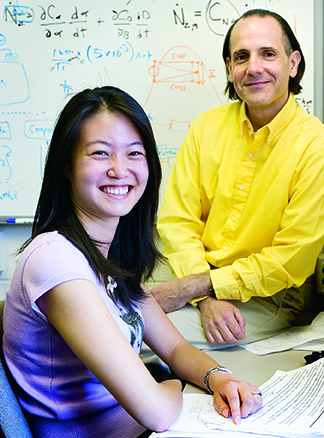
Lab Aids Virginia Tech Students April 2007
On April 16, a mentally disturbed student shoots and kills 32 Virginia Tech students and faculty members, and injures more than a dozen others before killing himself. Virginia Tech engineering professor Kevin Granata, formerly of the Submarine Technology Department, is one of three engineering professors killed. APL’s Matt Lear, who earned his doctorate in 2003 from Virginia Tech, learns that a member of his thesis committee is also one of the professors killed in the shooting. Lear becomes the center of a complex effort involving APL, Virginia Tech, Johns Hopkins, and two government agencies that will ultimately bring six Virginia Tech graduate students to Maryland so they can continue their research. Shown here are Amanda Young, doctoral candidate at Virginia Tech, and APL’s Neil Palumbo.
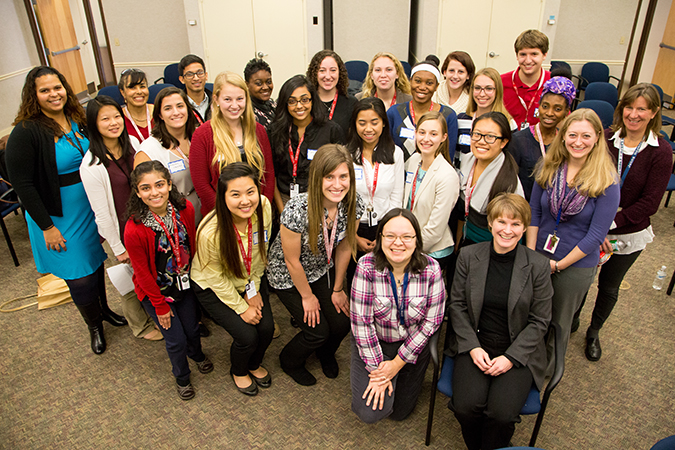
APL Chapter of the Society for Women Engineers Launches 2008
SWE@APL supports women engineers and other technical professionals at the Lab. The group partners with the Baltimore-Washington Section of the Society of Women Engineers (SWE), a not-for-profit educational and service-oriented organization that empowers women to succeed and advance in the field of engineering, and to be recognized for their life-changing contributions as engineers and leaders.
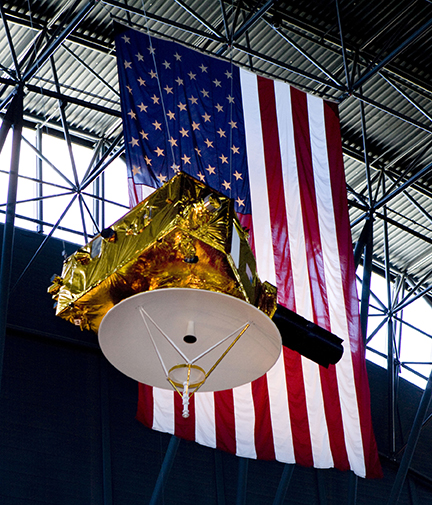
APL Donates Model of New Horizons to Smithsonian Udvar-Hazy Center in Chantilly, Virginia October 2008
A life-size model of the New Horizons spacecraft—provided by APL, where the real New Horizons was designed and built—is on display at the Smithsonian National Air and Space Museum’s Steven F. Udvar-Hazy Center near Washington Dulles International Airport in Northern Virginia. The New Horizons display is at the far end of the James McDonnell Space Hangar, behind the space shuttle Enterprise.

Lab Honors the Greatest Generation April 25, 2009
About 100 employees from APL help escort 125 World War II veterans from the Huntsville, Alabama, area during a daylong tour of memorials created in their honor. The veterans arrive at Reagan National Airport to cheering crowds, including USO representatives, passing travelers, and the APL staff members who would be their companions for the day.
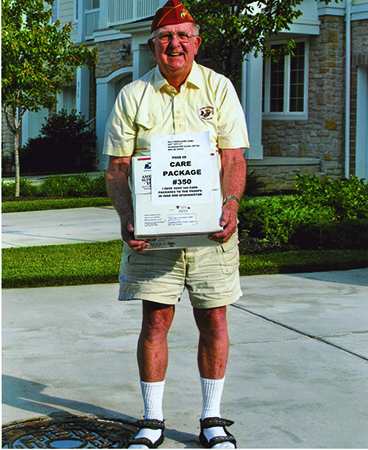
Care Packages for the Troops October 2009
Donald Downer (ret. 1989) packs the 478th and 479th care packages—with a variety of contents, from candy, cookies, canned chicken, and beef jerky to playing cards, paperbacks, baby wipes, and, of course, Spam—to troops in Iraq and Afghanistan, all done over the past 15 months with his own funding. “It feels like a mandate to me,” he explains. “I was deployed, and I know how much it means to receive a package overseas.” Downer, who worked for 33 years in the Fleet Systems Department, keeps a meticulous file listing the contents down to the last detail, and containing the receipts and customs form. “I’m an engineer,” he laughs.
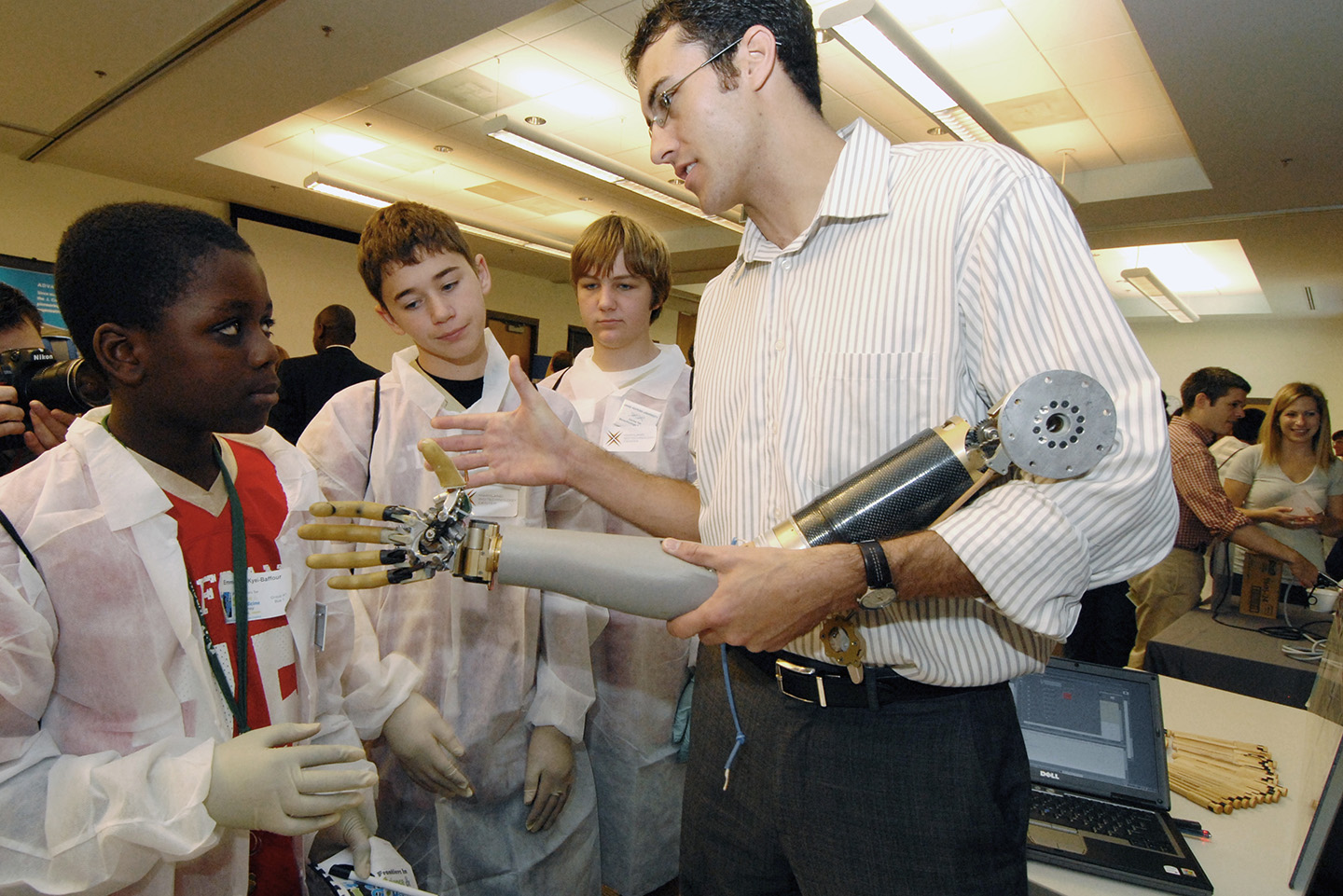
Prosthetics Demonstrations to Students October 9, 2009
Staff members Bobby Armiger (right), Todd Levy, and Courtney Moran (not pictured) participate in the Frontiers in Science and Medicine event at the Johns Hopkins University Shady Grove Life Sciences Center. The event is organized to inspire young students and encourage their interest in science and medicine through hands-on demonstrations. The three staffers give kids the opportunity to “shake hands” with a prototype limb system and enter a virtual integration environment to play the video game Breakout. During lunch, they also answer students’ questions.

Helping Cambodian Villages in Need November 2009
In 2005, APL staff member Ted Nieman and his wife Bonnie founded Cambodia We Care (CWC), a not-for-profit agency helping to alleviate poverty in Sambour, Cambodia. The organization’s first project raised money to install 1,000 wells throughout the Pouk Province. In 2007, the organization helped reopen a one-room school in Sambour, hire two teachers, and establish a donation program for books, chalkboards, and supplies. The couple travels there in 2009—their sixth trip since 2005—for the opening of two additional rooms (including a library/community center).
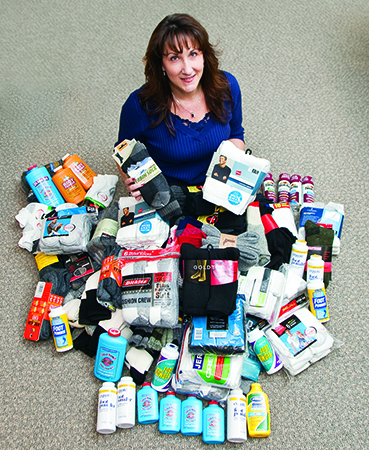
Support for the Troops December 2009
The National Security Technology Department’s Stefani Denner finds a link to “Adopt-a-Platoon” on APL’s intranet site and leads an “Operation Foot Care Patrol” drive for the troops. Participants give holiday cards, socks, nail clippers, and foot-care products to soldiers overseas.

Farewell to AN/SPG-55B December 15, 2009
The AN/SPG-55B radar that had operated from atop Building 40 for more than four decades is carefully lowered onto a truck and carried to its new home at the National Electronics Museum in Linthicum, Maryland. The radar once played an important role in U.S. Navy missile fire control systems, but since the last of the ships carrying that model was decommissioned in 1995, it had seen little use beyond experimental tasks. Building 40 housed the Terrier Land Based Test Site, including the AN/SPG-55B fire control radar built by Sperry Gyroscope Company. “From the very beginning, APL was instrumental in some of the advancements made to the system,” says Lex Hughes of the Air and Missile Defense Department. From left, retired APL staff member Leo McKenzie, National Electronics Museum Director Mike Simons, and APL’s Louis Judge, David Richmond, and William Tye prepare the 12-ton AN/SPG-55B radar antenna and mount to be lowered off of Building 40.
2010s
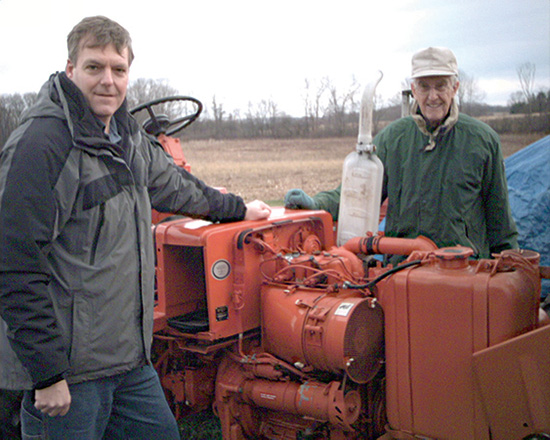
Staff Members Assist Haiti Earthquake Relief January 2010
On January 12, a massive earthquake strikes the island nation of Haiti, killing approximately 150,000 and laying most of the country to waste. APL staff members respond with generous fundraising, donated medical equipment, and heavy equipment. TractorShare, a nonprofit founded by the Lab’s Ron Buikema, was already working in Haiti when the quake hit. TractorShare provides technical assistance to agricultural communities, including the use of tractors by subsistence farmers and firefighters. Once Buikema learned their operations manager was safe and leading rescue efforts, the group focused on deploying heavy equipment capable of moving debris, clearing roads, and reestablishing essential services, such as water and electricity. Shown here is Buikema, left, with a tractor that made its way to Haiti before the disaster.
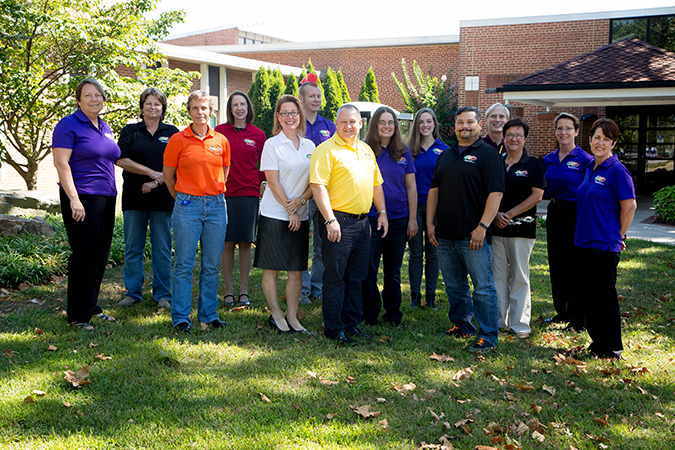
Allies in the Workplace Is Established January 2011
Allies in the Workplace (AIW) is formed to provide a voice and advocacy for the many LGBT and Allies staff members at APL. Since its inception, the affinity group has been an advocate to Lab leadership improving understanding and support, as well as insurance and medical benefits unique to the LBGT community. The AIW affinity group conducts an annual Pride awareness campaign in June.
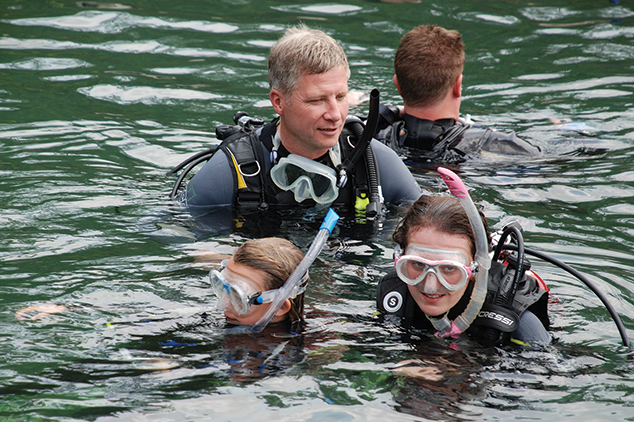
Helping Veterans Dive into Rehabilitation August 2012
Staff member Jeff Currer believes everyone should have the opportunity to see the two-thirds of Earth that is underwater, and for this scuba-diving instructor and Navy veteran, “everyone” especially includes injured military service members. Currer, who owns Patriot Scuba in Northern Virginia with his wife, teams up with the Wounded Warrior Project to help injured service members with their rehabilitative and transitional processes by certifying them for scuba diving. For amputees and paraplegics, the water provides both freedom and a new challenge. “Imagine if you couldn’t walk and were confined to a wheelchair, then got in the water and were weightless; it’s very liberating,” Currer says.
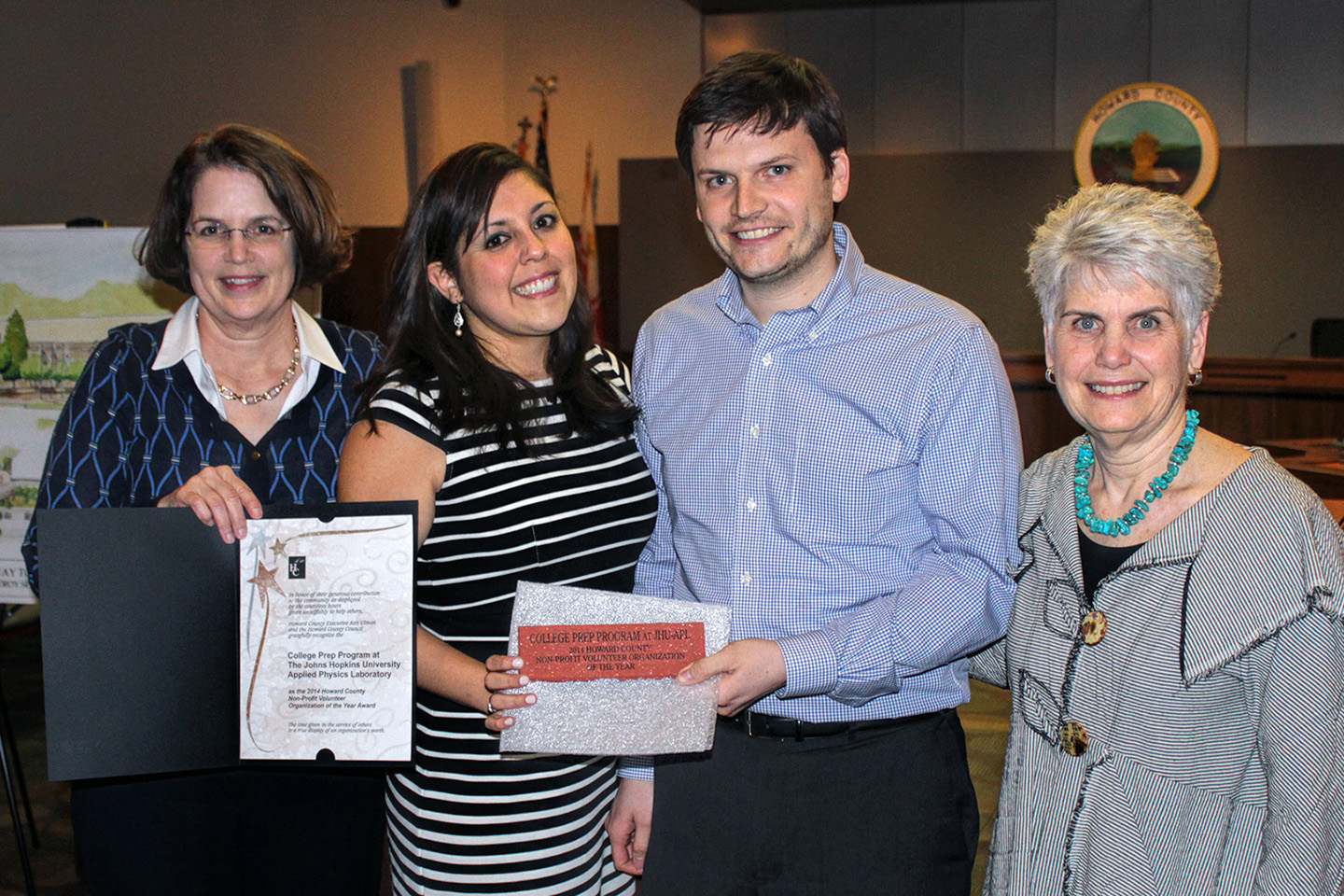
APL’s College Prep Program Earns Howard County Volunteer of the Year Honors April 2, 2014
The award, which honors outstanding volunteer efforts by individuals, nonprofits, and government agencies, is presented to Will and Karla Gray Roncal, a husband-and-wife team who co-lead the program at APL. Founded in 2009, all College Prep Program graduates have graduated from college, are in college, or are on track to apply to college during their senior year of high school.
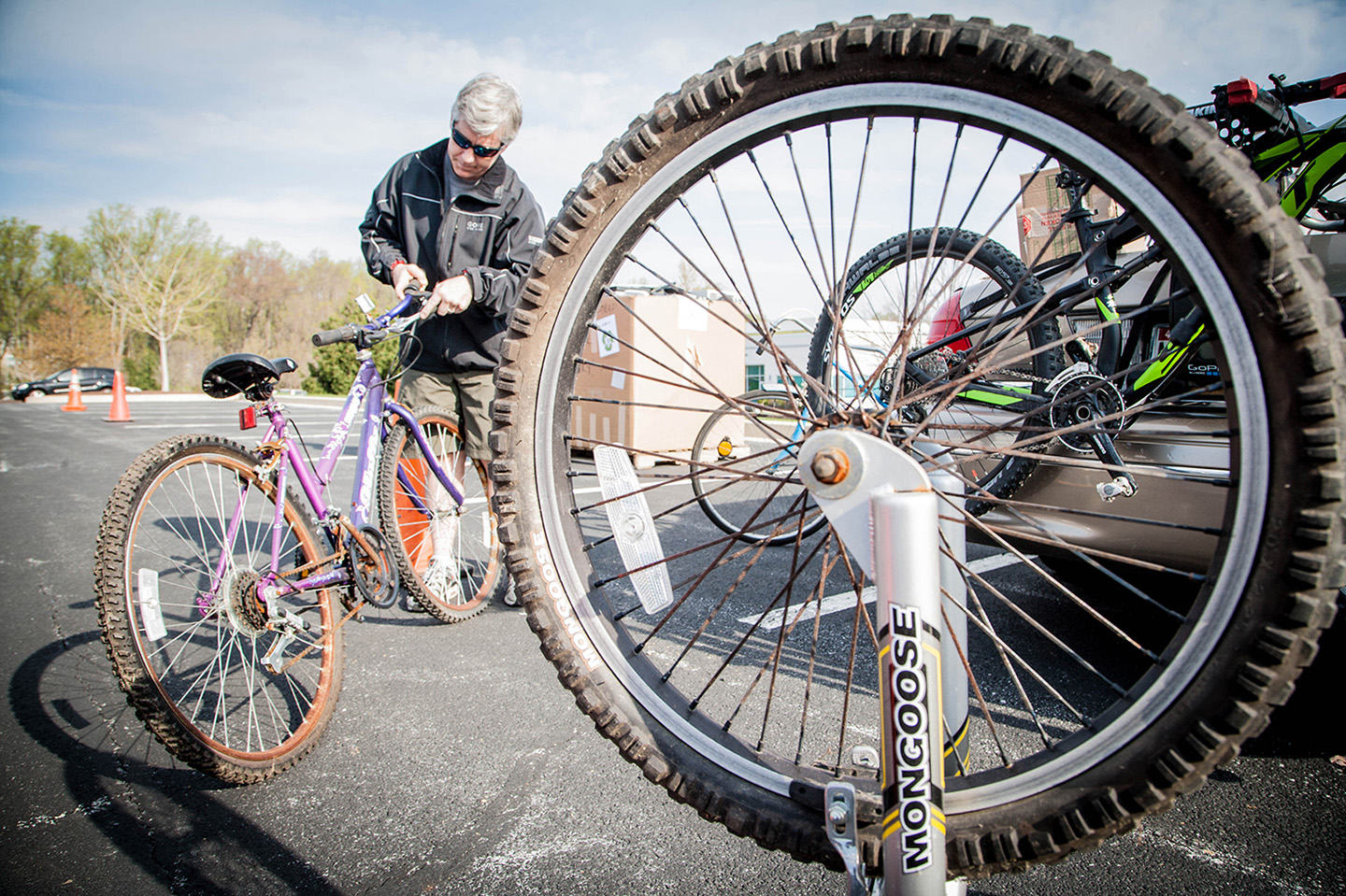
Staff Members Donate Bicycles and Glasses April 22, 2014
As part of APL’s Earth Day celebration, staff members donate bicycles and glasses to charity. The donated bikes are taken to Race Pace Bicycles in Ellicott City for cleaning and are sent to Bikes for the World, a nonprofit organization. The glasses are donated to the Optimist Club. Staff members also bring in personal papers and electronics for recycling.
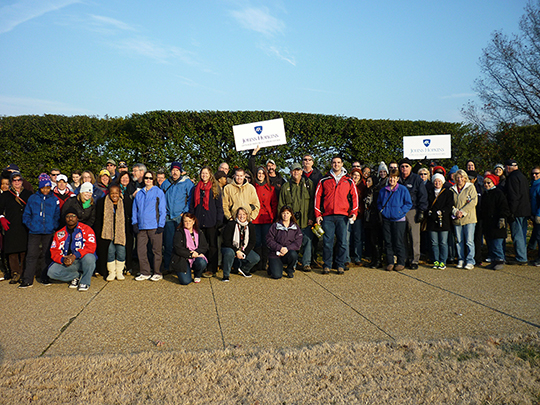
Wreaths at Arlington National Cemetery December 13, 2014
An APL group lays holiday wreaths at Arlington National Cemetery on Saturday, December 13, as part of an effort being coordinated with Wreaths Across America, an organization that began placing wreaths on Arlington’s headstones in 1992.
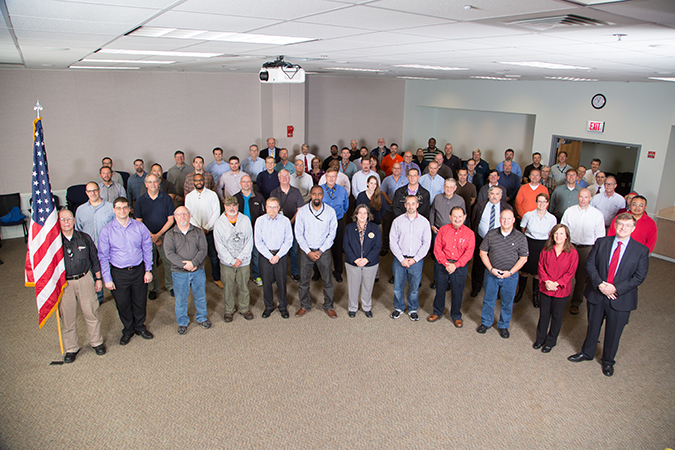
APL Forms Veterans Club 2016
The Veterans Club is created, serving as a resource for both veterans and staff interested in various activities and events honoring veterans at APL, like the annual Veterans Day staff portrait.
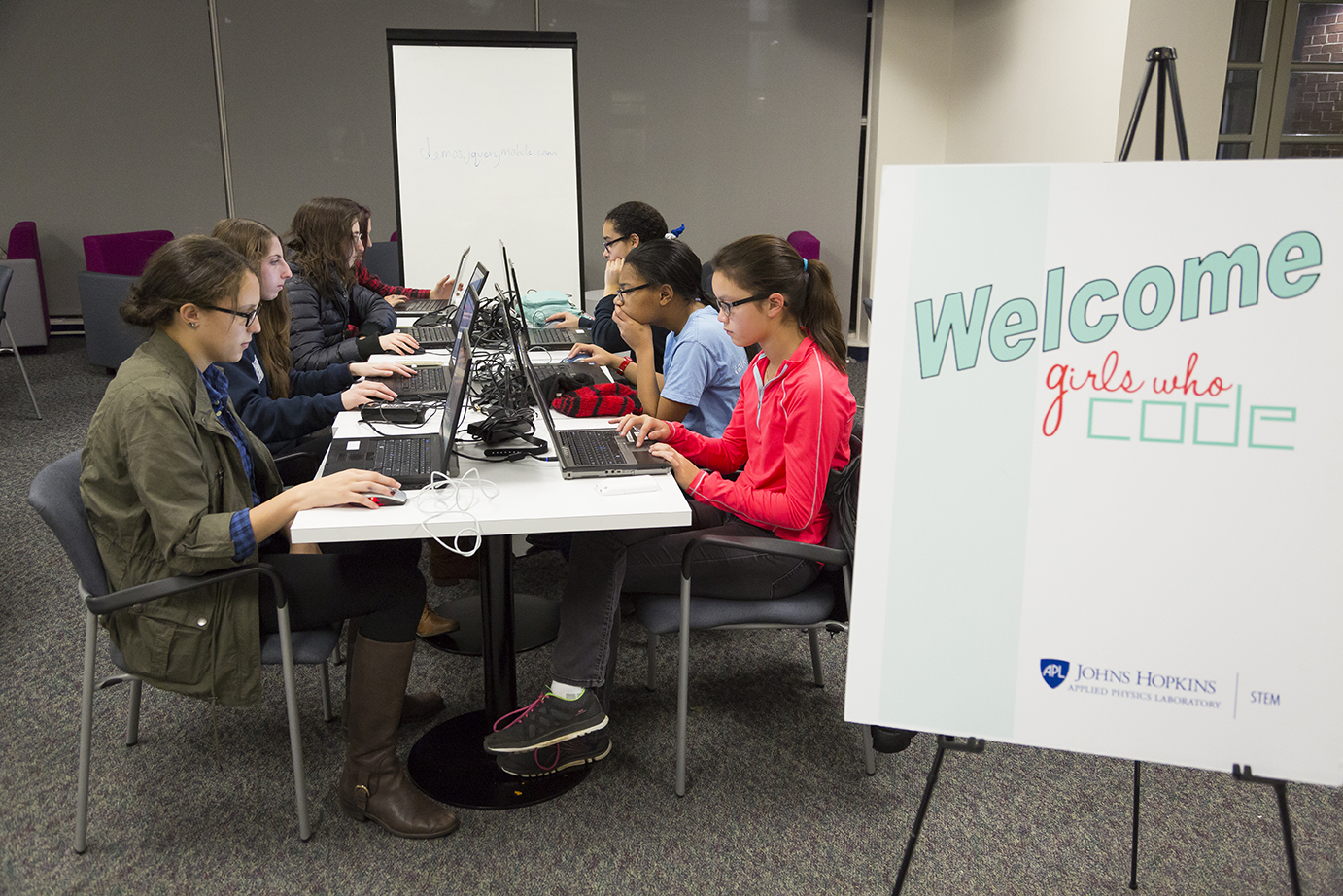
Girls Who Code 2016
A group of twenty local middle and high school girls spends Tuesday afternoons at APL learning both the science and art of computer coding from APL staff members as part of the Girls Who Code program. Girls Who Code is part of a national organization that works to inspire, educate, and equip girls with the computing skills to pursue 21st-century opportunities, with the ultimate goal of reaching gender parity in computing fields.

MESA Program Celebrates 40 Years 2016
APL’s Maryland Mathematics, Engineering, Science Achievement (MESA) program celebrates its 40th year of preparing pre-college students for academic and professional careers in STEM. Founded at APL in 1976, the program provides information and programming to more than 2,500 students and 180 teachers across central Maryland.
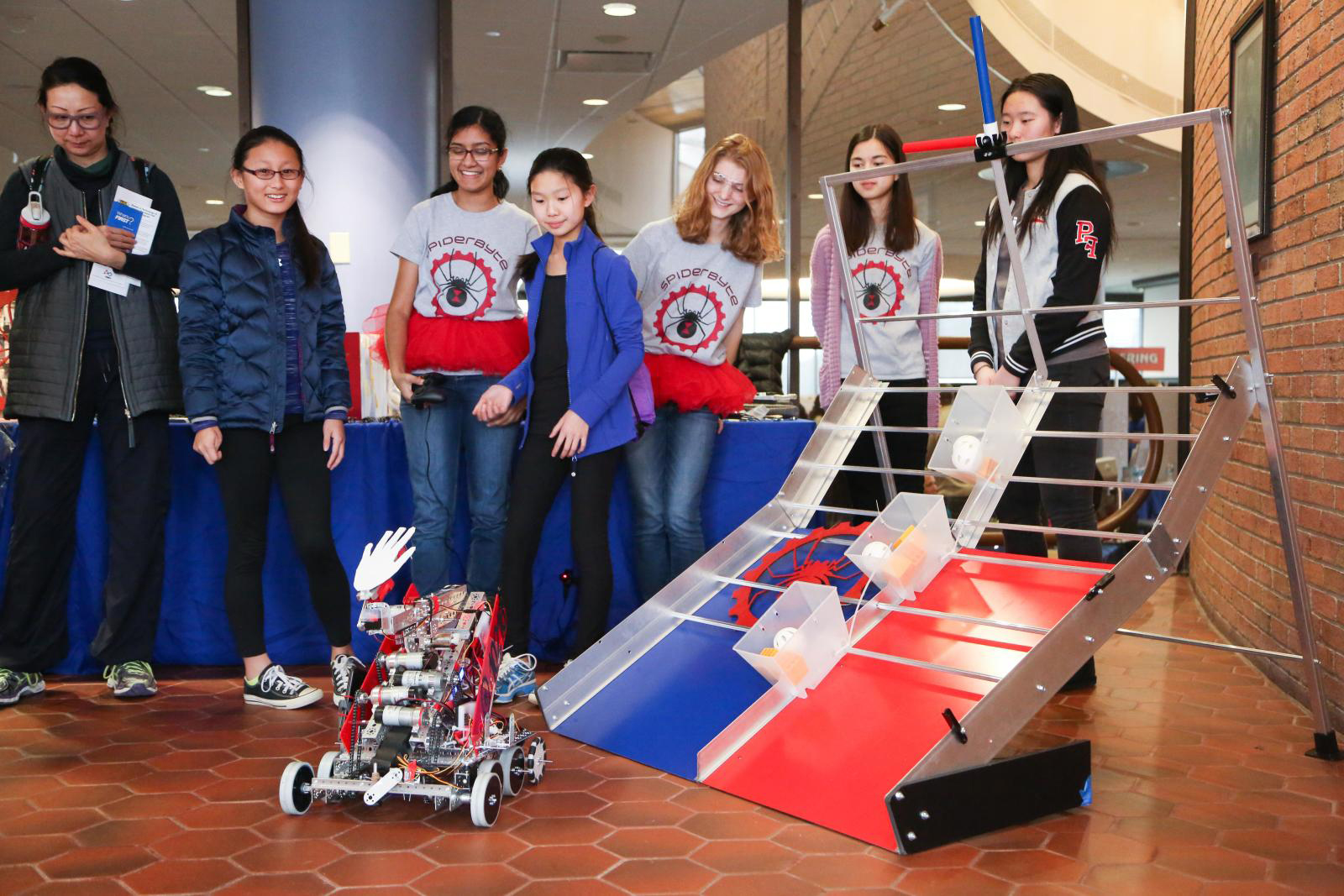
Girl Power Celebrates 10 Years March 6, 2016
The 10th annual Girl Power event draws more than 500 girls for an afternoon of exploration, discovery, and career advice. The expo, sponsored by APL, consists of various hands-on activities and demonstrations to encourage middle and high school girls to get interested and excited about science, technology, engineering, and math (STEM) fields.
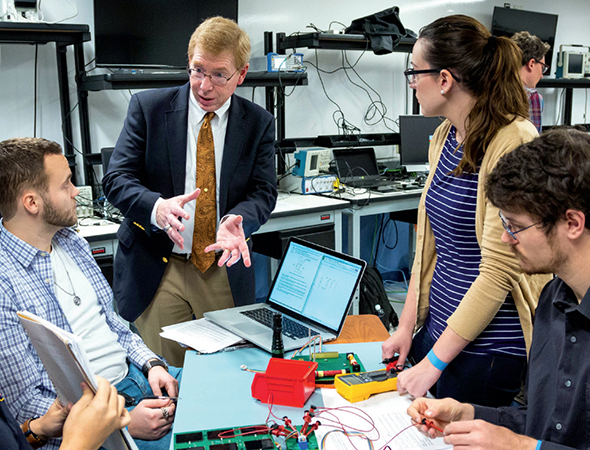
Continuing Education 2017
Keeping its staff members on the cutting edge of technology has been a goal since APL’s beginning. After the end of World War II, APL leadership took many steps to ensure the Lab would not become obsolete. One step was to offer informal education and training programs. In 1958, the JHU Evening College began sponsoring courses on campus for APL staff. APL created the JHU Evening College Center (APL Education Center) in 1964, offering a master’s degree in electrical engineering. Today the APL Education Center partners with the Johns Hopkins Whiting School of Engineering and its Engineering for Professionals (EP) Program. Since 1964, more than 18,000 students have earned master’s degrees through EP programs.
SWE@APL Earns Global Society of Women Engineers Awards October 2018
APL’s Society of Women Engineers (SWE@APL) chapter is honored with the society’s Mission and Best Practices awards.
2020s
Lab Announces Free and Discounted Programs, Resources for Parents
As part of the APL Forward Together plan, the Laboratory provides resources for parents of young and school-aged children, including information on several STEM summer programs.
Program Office Celebrates 10 Years of STEM Education and Outreach July 2021
APL’s STEM Program Management Office turns 10, and there’s a lot to celebrate about the decade of its dedicated efforts to develop the next generations of science, technology, engineering, and math talent.
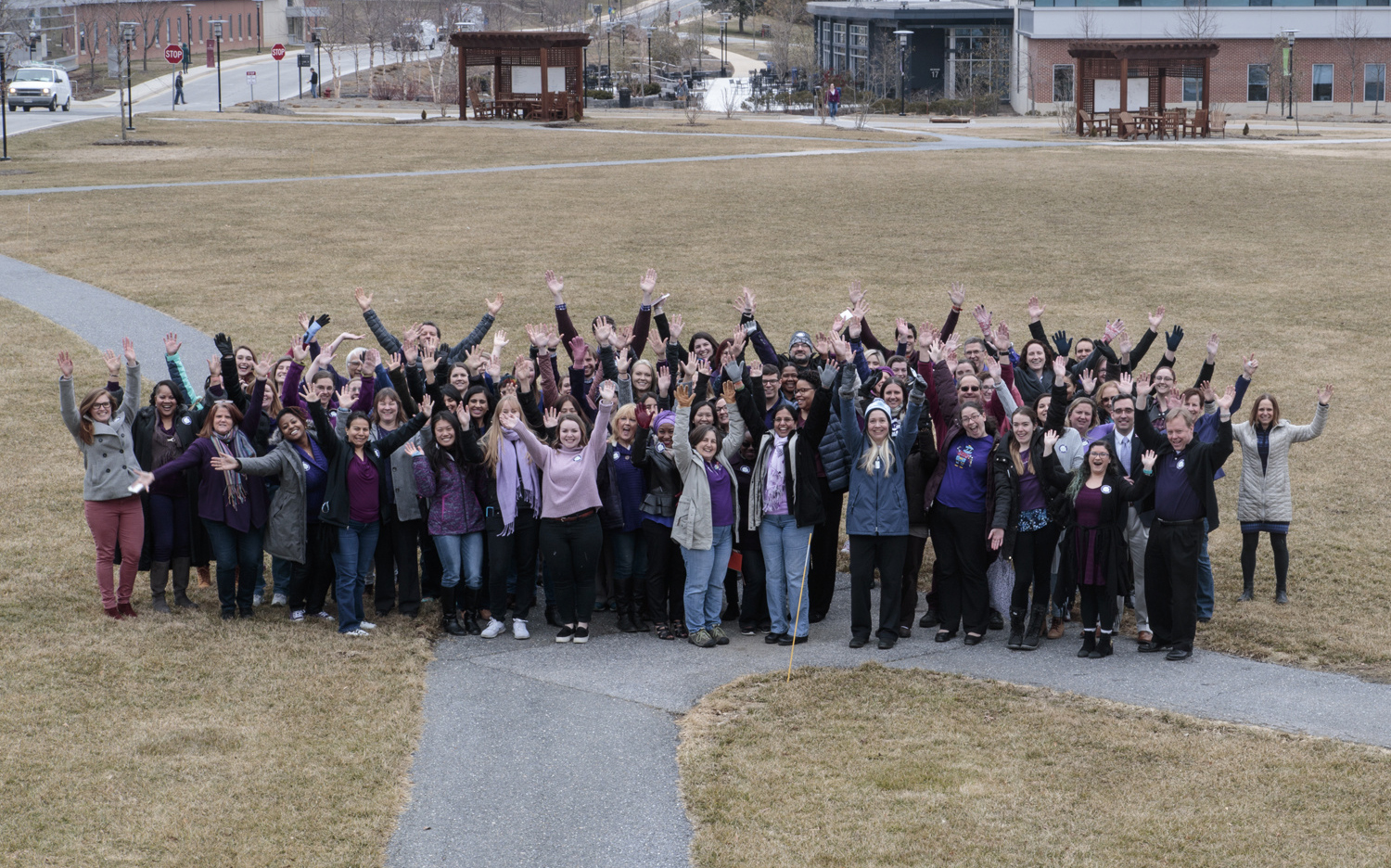
AWiT Recognized for Steadfast Efforts in Advancing Women in STEM → October 2021
The Lab’s APL Women in Technology (AWiT) affinity group is presented with its third consecutive Gold Mission Award from the Society of Women Engineers (SWE), an honor given to groups that demonstrate commitment to SWE’s four goals: professional excellence, globalization, advocacy, and diversity and inclusion.
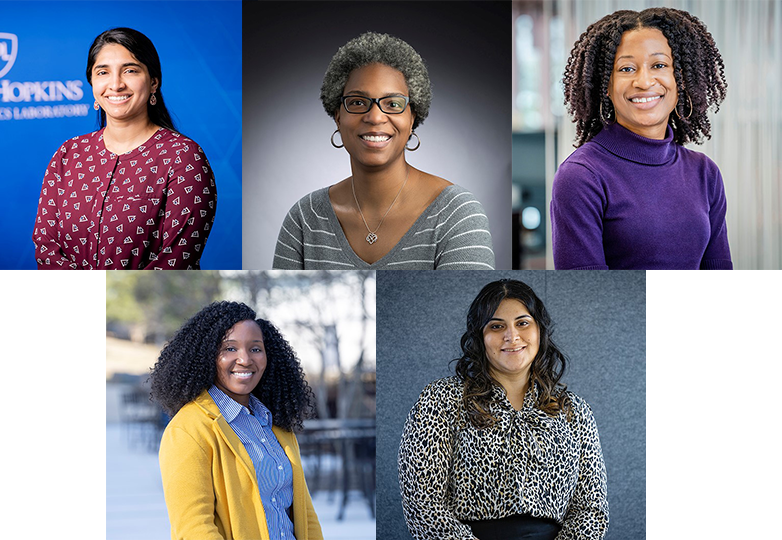
Five from APL Receive Women of Color Honors → October 2021
Five women from APL are honored with 2021 Women of Color (WOC) STEM Awards. The annual awards honor promising innovators and inventors who are making an impact in their disciplines as well as demonstrating a commitment to mentoring and encouraging women in STEM fields.